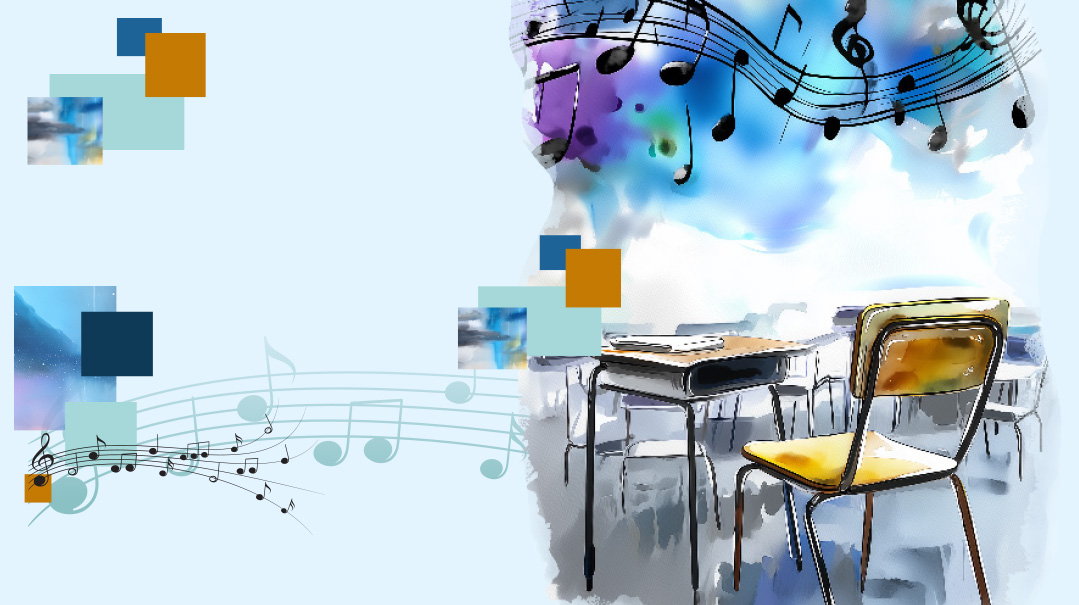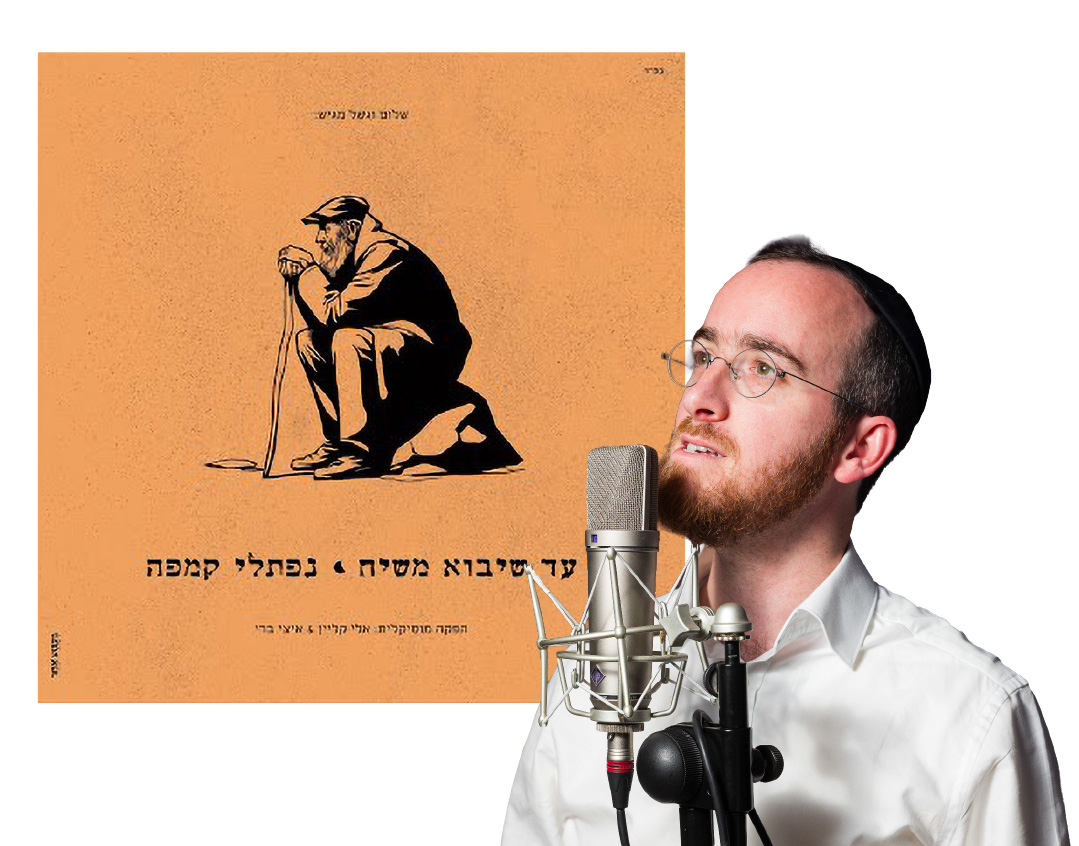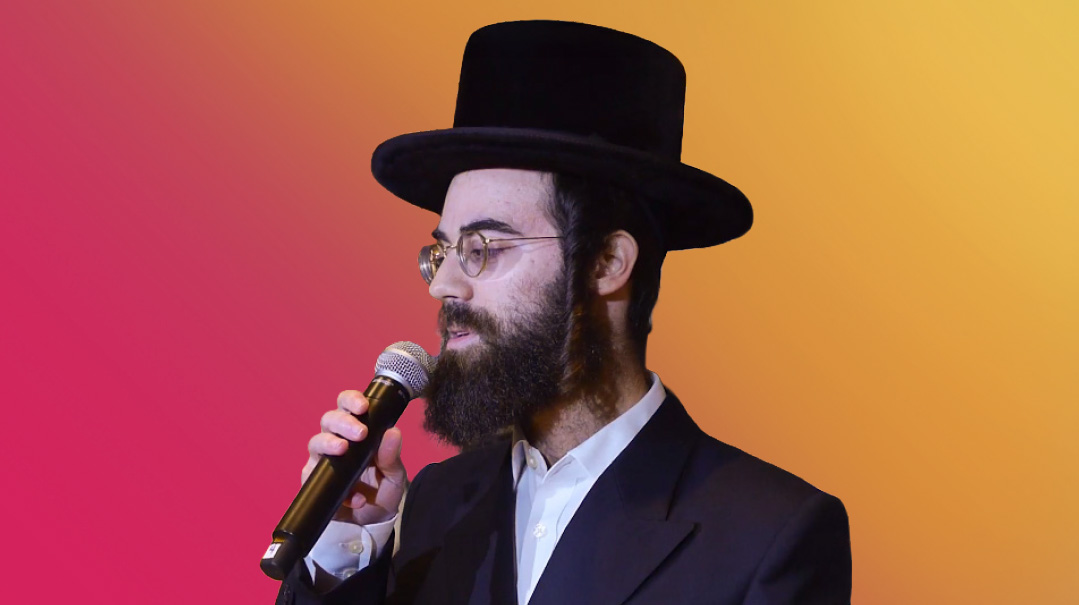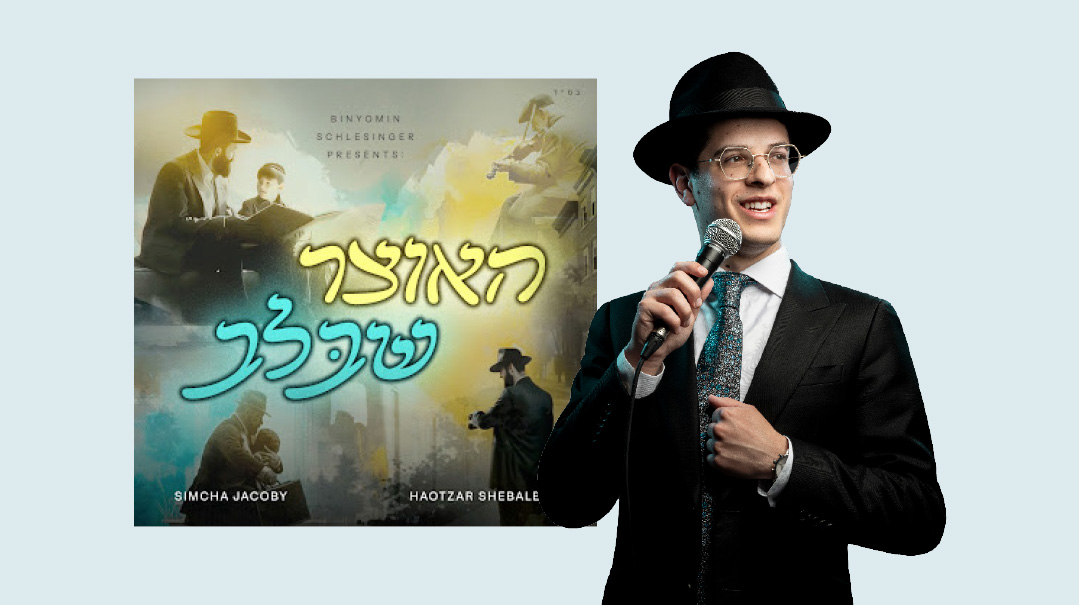Teach with a Beat
| May 27, 2025Is there a special niggun that has transformed your classroom?

Students spacing out? Kids unable to sit still, or academically challenged? In the classroom, songs can reach every type of talmid in a way the best lessons sometimes can’t. In moments when words fall short or attention wanes, a song can refocus the room, soften resistance, and invite students to feel rather than just think.
Shift of Heart and Mind
Rabbi Yirmi Ginsberg, mashpia in Aish Kodesh, Woodmere, NY
We’ve developed a unique shiur called the Niggun Chaburah. It begins with a song, and we listen carefully — sometimes with the lights off — to allow the melody to speak directly to the heart. Then we learn a Torah idea that connects the message of the song to the weekly parshah or an upcoming Yom Tov. After the learning, we return to the song. But this time, the music is different. With Torah as our lens, the melody takes on new depth, entering our hearts in a way it couldn’t before.
Two years ago, just before Rosh Hashanah, I invited Aryeh Kunstler to join us for a Niggun Chaburah gathering with a group of women. He shared a newly released song, “Avodat HaLev” — a powerful piece about the struggle and beauty of serving the King. The lyrics capture the tension of being an eved Hashem, and offer a gentle reframe: The King we serve is also our loving Father.
That night, we learned about Chanah, the mother of Shmuel Hanavi. Chanah endured years of pain, as her husband’s second wife bore child after child while she remained barren. Year after year, she ascended to the Mishkan with her husband, pouring out her heart in tefillah, until one year, something changed. Chanah had a breakthrough. She realized that her request, though deeply human and understandable, was focused on her own pain and desire. In a moment of profound clarity and surrender, Chanah reframed her prayer. She told Hashem, “If You bless me with a child, I will give him right back to You. I don’t want a child just for myself — I want to bring this soul into the world to serve You.” It was that shift — from personal desire to Divine purpose — that opened the gates of blessing. Chanah subsequently gave birth to Shmuel, one of the greatest prophets in Jewish history.
Several months later, during another Niggun Chaburah event, a young woman who had attended that Rosh Hashanah shiur shared her news, glowing with joy. “Mazel tov,” she said, “I’m a kallah!”
She shared that for years she had been davening for a chassan, but her tefillos seemed to go unanswered. After hearing the shiur about Chanah’s tefillah and mesirus nefesh, something shifted inside her. That Rosh Hashanah, she spoke to Hashem with new clarity: “You are the King. You know what You’re doing. I surrender my will to Yours. I want to serve You — whether with a husband or without.”
A few months later, she met the man who had been ordained for her.
This is the power of a song when it’s paired with Torah. It’s not just a melody — it’s a tefillah, a hisorerus, a key to transformation. That’s the essence of the Niggun Chaburah: When the mind and heart serve together, Hashem responds in ways we never imagined.
Longing for a Soul
Rabbi Menachem Moscovitz, executive director, Mesivta of Las Vegas
AS a rebbi in an out-of-town mesivta, I’ve had the privilege of guiding bochurim from all walks of life. One morning, while teaching about the neshamah and our mission in This World to refine and elevate ourselves, I shared Abie Rotenberg’s timeless song “Neshomele” (Journeys II) with the class. We listened closely, unpacking each stanza and discussing its profound messages.
One of my students was a particularly bright and sensitive young man who was in the midst of the geirus process. He sat silently, absorbing every word. When the song ended, he looked at me and asked if I could play it again. I did.
The following day, I received a phone call from his mother — an extraordinary person and a giyores herself — who shared with me how her son had come home deeply moved. He explained the song to her with emotion in his voice and tears in his eyes, telling her how much he longed for a Jewish neshamah. He had been grappling with the difficulty of parting from his past and his old friendships, but “Neshomele” pierced through those barriers and gave him clarity and strength, catapulting him to where he really wanted to go.
Today, that young man is a proud member of Klal Yisrael.
Link in the Chain
Rabbi Yechiel Haboura, third-grade rebbi, Detroit
I teach niggunim to my third graders, and I make sure they can sing them on key. I believe niggunim have a special power. Over the years, I’ve found that when I teach Chumash, some boys are more connected, and some less. I do whatever I can do for each talmid, on his level. But when I teach a niggun, everyone is involved and everyone is uplifted.
I had a talmid from a troubled home who found learning a challenge, but singing was like food for his soul. The niggunim built his confidence and really gave him everything I would have hoped to give him through learning.
Two specific songs that are very special to me are the old “Veha’er Eineinu b’Sorasecha,” with words from Shacharis, and “V’hi Noam,” (Haneshamah B’kirbi) as sung by Motti Steinmetz. My rebbi, Telshe Chicago Rosh Yeshivah Rav Shmuel Yehudah Levine, loved these niggunim. When I sing them with my talmidim I feel like I’m passing on something powerful that connects me to my rebbi.
At the end of each year, I invite the boys and their fathers to my home for a father-and-son kumzitz. The confidence they gain from singing well breeds confidence in their learning.
Niggun Was the Key
Rabbi Eli Mann, fourth-grade rebbi, Toras Emes Miami
MY fourth graders looked at me with blank faces.
Most years, once my class learns the niggunim we use for Shacharis, I can stop singing during davening and let them carry it. Not this class. I’d start, then stop, and they’d stop, too. Every. Single. Time.
Most of them didn’t sing. A few didn’t even open their siddurim. It was me, my guitar, my voice… and maybe one or two kids half-singing on any given day.
There was one boy in particular, who was not a davener or singer. He’d sit there every morning, knees up, siddur open but eyes blank. He was quiet, not disruptive… just distant. Davening wasn’t “his thing.” He was great at sports, he did his work (eventually), but he didn’t sing — he just sat.
About two or three weeks before the end of the year, we were singing — if I recall correctly — the third Hallelukah to the tune of Hallelukah from Yehudah! when I stopped singing, out of habit, and for the first time all year, the class kept going. I paused. They were singing.
And that boy? Knees up. Same blank look. Same quiet posture. But this time… he was humming.
If you’ve ever had that kind of “aha” moment as a rebbi, then you know what true teaching nachas feels like. His mother later told me that since that year, he’s opened up emotionally. He sings. He plays an instrument. Music has become part of his world.
Music has a power, an energy. It can open up anyone.
Grabbed by the Heart
Rabbi Joseph Werner, third-grade rebbi and mashgiach ruchani, Hebrew Academy of Long Beach
Each morning, as my students come in for the day and get themselves settled, I have a minhag to put on some music, either a song with words or a wordless niggun, to create the right atmosphere and help open hearts for davening. One day a couple of months ago, I chose Eli Dachs’s composition “Niggun Baleiv.” I played the song and sat working at my desk, but suddenly I became aware that the boys were enjoying it and some were humming. The next morning, I decided to repeat that niggun. About halfway through, I lifted up my head to see the entire class, 22 third-grade boys at HALB, singing along with the niggun, k’ish echad beleiv echad. I had never seen a reaction like this before. It was as if it had grabbed them by the hearts.
I could see this was something special, so I recorded the class singing and sent it to Eli, who is my son’s friend. I felt that if the niggun had entered the boys’ hearts in such a way, it was obviously “devarim hayotzim min haleiv.” Eli was excited and offered to come and sing with the boys, and it finally worked out for Lag B’omer morning. It was a beautiful experience that I think the boys will not forget. Somehow this niggun created an avenue for these neshamos to blaze forth. The boys in this community are not so sheltered from the outside world, and this was an opportunity to combat that and be mechazek them with a genuine, hartzige outpouring of niggun.
Looking out for Amar Abaye
Rabbi R.B., high school rebbi, Eretz Yisrael
I taught my talmidim a song composed by Reb Moshe Shmuel Shapiro ztz”l called “Amar Abaye,” and they wait for an “amar Abaye” in the Gemara and beg to sing it. You can find the song on Kol Halashon. It has three parts, all just to the words “amar Abaye.” The first part is before understanding what Abaye was saying, the second part is beginning to understand, and the third part is when one finally reaches an understanding of the holy words of Abaye.
The song is profoundly simple and short and we sing it a few times whenever we come to an “amar Abaye” while learning. The composer, the great rosh yeshivah of Beer Yaakov, was renowned for his ahavas haTorah and would incorporate singing as he conveyed his love and longing to his talmidim. Many of the songs that he taught his bochurim were his own compositions.
Singing with 15-year-old talmidim in class is not always so easy. Some boys are embarrassed or “not down.” Yet when we are able to break these barriers, we connect on a deeper level in the classroom. It also provides a Torah-oriented pause in the learning that can revitalize the class. It’s fun for the boys and keeps them tuned in — as they know there may be an “amar Abaye” just around the corner.
You Never Know
Nachum Chernofsky, Bnei Brak
When I was 20 years old (more than 50 years ago!) I applied to YU seminar to be a counselor, and was accepted for the job. While not knowing how to play an instrument, I was very musically inclined, so I took along a tape recorder and a cassette tape of the Or Chadash album with “Shmelkie’s Niggun” on it.
Henry, one of my guys on the seminar, was a 14-year-old kid who was a freshman at a public high school. I played for him the Yiddish song from this album entitled “Aleh Yidden Zeit Tsufrieden.” Of course, I had to translate the song into English, but by the time we got to the cholent and the fish part of the song, he was hooked, line and sinker (pun intended).
After returning home, he asked his parents if he could keep kosher, which they agreed to and even bought him his own fridge. Upon graduating from public high school, he went to the introductory Jewish Studies program at Yeshiva University, followed by a year at Yeshivat Sha’alvim.
We lost contact following that year, but about 20 years later, I found him over the Internet and we reconnected. He was married and had four yeshivah bochur sons. I once asked Henry what the turning point in his life was and he confirmed that it was that song from so many years ago. As Reb Shlomo used to sing, “You never know.”
Get Back Up
Shlomo Reich, Cofounder / Codirector of The Shaar
I have the awesome zechus to learn chassidus with the chevreh here, who are baalei teshuvah. One of the most powerful tools I use is music. I bring my guitar in and begin each session with a niggun — a soulful, chassidishe melody that sets the tone for the Torah we’ll be learning. These aren’t just warm-up tunes. Each niggun is a handpicked chassidishe melody that carries the essence of the Torah we’ll be learning that day. Sometimes it’s a wordless dveikus niggun from Karlin or Modzhitz. Other times it’s a soulful song by Shlomo Carlebach or a newer composition that somehow captures a timeless truth.
For example, before we learn a piece of Tanya on the nefesh haElokis and nefesh habeheimis, we might sing something that stirs the inner struggle. When learning a piece from B’Yam Darkecha or Nesivos Shalom, we might sing a haunting Modzhitzer niggun that brings the heart into focus.
As they sing, you can see on people’s faces that inner walls are coming down. For baalei teshuvah, music often does what words alone cannot. It bypasses the intellect and speaks directly to the soul. Torah and niggun together create a perfect symphony of dveikus.
Once, when I was leading a “Hachanah leShabbos” farbreng at The Shaar, together with some local community members, I started singing and playing the well-known niggun attributed to the Kedushas Levi — a melody that starts slow and tender, almost broken-hearted, and gradually builds in tempo until it erupts into ecstatic joy. As we sang, I started adding the words that have been made so well-known by Reb Joey Newcomb — “You fall down, you get back up” — and the chevreh began to sway, then clap, then get up and dance. The energy in the room transformed from quiet yearning to a full-blown, holy frenzy of hope and simchah.
Afterward, Bradley, one of the newer guys who was still wrestling with his past lifestyle came over to me, visibly moved. He told me how hard it’s been to shift from a world of hedonism to one of mindfulness, growth, and connection. He’d been feeling like every slipup meant failure. But with this niggun, something clicked. At that moment, he internalized that falling back into old habits wasn’t the end — not if he kept getting back up. “That song drove home to me,” he said, “that Hashem cherishes the getting back up even more than the staying up.”
It’s About the Connection
Rabbi Shmuel Chaim Brody, second-grade rebbi, Talmudical Academy, Baltimore
I teach a ‘Niggun Hashavua,’ a song of the week. A song can ignite a genuine love for Yiddishkeit, and it doesn’t need to be earned by good grades or memorization.
For Shavuos we’re learning a song called “Hillel’s Love” by Rav Ephraim Wachsman. The boys love it, and beg to learn a few lines every day. Some of them struggle to keep up academically, yet with this they can soar, and carry it into their future.
One of my students loves singing at the Shabbos table. He sings the weekly niggun with his family, sometimes teaching them a new song, and it gives him a tremendous sense of pride in his rebbi, in his learning, and that he’s bringing his family closer together. In the end, it’s about the connection, from father to son, and from rebbi to talmid.
Through the Tough Times
Rabbi Chaim Gershon Davis, ninth grade rebbi, Yeshivah Darchei Torah
I teach the bochurim a lot of songs, mostly my own compositions. The yesod of a niggun is “Vehasheivosa el levavecha” — bringing the messages of Torah home to your heart. We start off shiur every day with a discussion of a topic in mussar or bein adam lechaveiro, and each week I teach a song that goes with the message. I find that teaching a niggun that is my own song, which I give over with real passion, draws the boys in even closer.
Every year, I speak at the Long Beach yeshivah. One year, I had just composed my song “Shteigen” on a Shabbos morning, and I taught it to the Long Beach bochurim that Motzaei Shabbos. It’s about continuing to learn in every situation you find yourself in. A while later, a bochur called me to share that when he heard that song, his chavrusa had just dropped him, and he was left to learn alone. The song helped him to learn through that tough time. It was later released by Shloime Taussig, who heard it from my bochurim in camp.
Get the Message
Rabbi Yehuda Pfeffer, Sixth Grade, Cincinnati Hebrew Day School
I use certain songs to learn mussar with my class. For example, we take Abie Rotenberg’s Journeys songs, like “The Cat Ate the Canary” or “Little Tree,” and we listen to the song while the boys try to figure out answers to the pointed questions I’ve prepared for them.
If I’m getting a vibe that boys in the class are having a hard time not broadcasting their vacation plans, I’ll play “The Wedding Song,” and we’ll discuss the value of modesty in the song, which gives them a message without hitting them over the head. Last year, with the ongoing matzav in Eretz Yisrael, I played Abie’s song “Little Tree” to the entire middle school. When the boys got the message — that the entire world, from the Europeans to the Arabs and the United States, has something to say about Eretz Yisrael, they got very emotional.
When you ask a boy to sing, you’re asking him to come out of his comfort zone. The classes who get along well, who are b’achdus, sing together best, because they trust each other and can let down their guard to sing. In a class where there is tension or a bit of unhealthy competition, it’s much harder for boys to relax and sing. If they aren’t comfortable, don’t push the singing too much, because they’ll pull away.
Word by Word, Line by Line
Rabbi Moshe Dov Heber, Yeshiva K’tana of Waterbury
During my first year of teaching, seven years ago, I played a song for my class that had been composed by Rabbi Meltzer’s class from the Yeshiva of South Shore. The song, called “Ta Shema,” was about the challenge — and the reward — of learning Gemara with real effort. The message struck a deep chord with my boys. They loved it so much that one day, we even called the class who composed it just to connect and share how much their song meant to us.
One of the lines in the song says: “if you are willing to work hard — word by word, line by line....”
That line became a kind of motto for us.
I recently got a call from one of my talmidim from that year, Kalman. Today, he’s a top bochur, learning seriously, growing steadily. And yet, despite all he’s accomplished, he told me, “Rebbi, I still think about that line all the time — ‘word by word, line by line.’ It reminds me that even when learning feels hard, that’s exactly where the growth is. It brings back great memories... and helps propel me forward.”
Sometimes, all it takes is a single line of a song to leave a lifelong imprint.
(Originally featured in Mishpacha, Issue 1063)
Oops! We could not locate your form.







